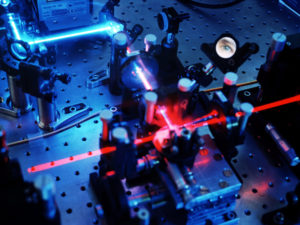Field-programmable photonic gate arrays with fast switching times

Photonic circuits allow data to be transmitted at the speed of light with minimal loss. Sound appealing? The global markets think so – estimates are predicting the market size for photonic integrated circuits (PICs) to reach $3.7billion by 2027. Demand predictably originates in the telecommunication industry, having to manage ever increasing amounts of data, especially when interacting with IoT, cloud technology or AI. However, potential uses in new fields are being realised all the time – including quantum computing, optical sensing and biophotonics.
While the initial developments are promising, the industry requires significant further innovation before substantial infrastructure will start to appear in our daily lives. Nevertheless, researchers at Oxford have made significant gains in this sector. The newly developed photonic field-programmable coupler array (FPGA) is effective at addressing all of the issues mentioned.
FPGAs in electronic circuits have been used for many years as part of the prototyping process. The programmable interconnectors allow for new functionality to be designed and tested in a matter of weeks without being prohibitively expensive. For this reason, FPGAs have been at the forefront of efforts to enable ever more computationally intensive systems. This has been the main focus for artificial neural networks and machine learning applications. However, the opportunities for using similar circuits in the field of photonics has not previously been fully examined.
Typically, FPGAs comprise of arrays and a series of logic blocks with hierarchies of ‘reconfigurable interconnects’. A user can configure these interconnects in different ways so that the logic blocks can perform various functions (often in parallel). Researchers at Oxford have been developing a new approach to photonic coupler arrays, making use of phase change materials (PCMs).
The device consists of parallel arrayed waveguides that exploit evanescent coupling between phase-matched and phase-only Sb2S3-SOI hybrid waveguides. The photonic FPCA can be configured after fabrication as desired by post trimming/switching of Sb2S3 for use in networks such as:
-
- In the wavelength domain –
* Spectral signal processing
* Filtering
* Spectral shaping - In the spatial domain –
* Light guiding and routing
* Beam shaping - In the temporal domain –
* Temporal differentiation
* Tunable optical true delay line
* High-speed error correction
- In the wavelength domain –
The team at Oxford has developed a prototype of the new coupler array technology and a patent application has been filed. The purpose of the work is to realise as many functions of the technology as possible such that end users can program depending on their own needs.
Oxford University Innovation is seeking commercial partners to help develop the technology and bring it to market together with the research team.
about this technology

